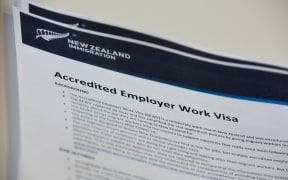
Most migrants who have been employed since 2021 are on at least the median wage of about $30 an hour. Photo: 123rf
Workers are finding out their overseas colleagues are being paid more, with companies and lawyers saying it is brewing discontent in the workplace.
More than 30,000 companies in New Zealand have become accredited to employ migrants since 2021, and most migrants at those businesses must receive at least the median wage - about $30 an hour.
With the minimum wage set at $23, some local staff have realised they are not getting the same salary as their overseas workmates.
"We've had instances where you have two people working alongside each other doing the same job and one's a migrant and one's not - and the migrant wage to bring them in under the scheme would in some cases have been significantly higher or maybe a couple of dollars an hour higher, and that's caused some friction," Employers and Manufacturers Association head of advocacy Alan McDonald said.
"If the guy next to you or the person next to you is doing the same job, it's identical and they're only getting more because they had to be paid the median wage when they came in, then obviously the expectation of the workers around them is that they will also get that level of reimbursement as well."
Resentment could also fester because migrants cannot exceed a number of hours according to their visa terms. That could create friction with local colleagues who do not want to work longer hours, while migrants may want to get overtime pay.
Businesses had been paying the market rate previously and were having to level up the rest of their workforce to the more expensive visa-required threshold when they could not afford to do so, McDonald said.
The Council of Trade Unions said the Accredited Employer Work Visa's wage requirement raised the pay of local staff and ensured businesses did not use overseas labour as a way of keeping costs down.
Whereas some pay disparities may not be visible, workers could find publicly available information on migrant rates to know what their colleagues are earning.
"We know that employers in particular have made a bit of noise about this because they resent not being able to pay people less," CTU president Richard Wagstaff said. "It does have an effect to lift wages in the sector which was why we support it. Where employers are employing local people and they have migrant workers under the scheme, we would expect that they would employ their local people, the domestic labour force, on the same rates.
"It's long been our view that pay should be transparent, and people doing the same job should be getting the same pay. Where workers aren't being paid those rates, and they think someone is being paid more, as you can imagine that would be a source of concern."
Employment lawyer Barbara Buckett said workers may get paid more because the visa mandated it, or because the employer had to pay more anyway to attract in-demand staff, especially in healthcare.
Either way, it could stir up racist sentiment and resentment among staff whose pay has not also gone up, she said.
"People talk around the water cooler and then something slips - and somebody finds out that they're being paid less than somebody that's come in from overseas and managed to achieve a great pay rate."
Added to that were exemptions, or differing minimum salaries according to migrants' industries, which were complex and seemed inconsistent with a fair bargaining regime under the Employment Relations Act.
Migrant workers among fishing crews must be paid $5 above the minimum wage, bus drivers get $28, while the threshold for highly skilled jobs varies but can sit between $36 and $65+ a hour.
"There are exemptions that can be made and they seem in themselves to be quite arbitrary and discriminatory," Buckett said. "They seem dependent on the strength of the industry's ability to negotiate with the policy determinators or remuneration setters."
Immigration lawyer Lauren Qiu said most employers were already very aware of pay sensitivity and were doing their best to match or come close to the Accredited Employer Work Visa median wage.
"Where I have seen pay disparity, is where the employer is under considerable financial pressure themselves, where they need the Accredited Employer Work Visa employee to fill a critical role but cannot temporarily also provide a pay increase to the same level for their existing employees.
"It is often a matter of survival and not out of malice. In these scenarios, depending on the pay disparity, the resentment is usually directed at the employer. Employers are the ones left to wear most of the external pressures."





